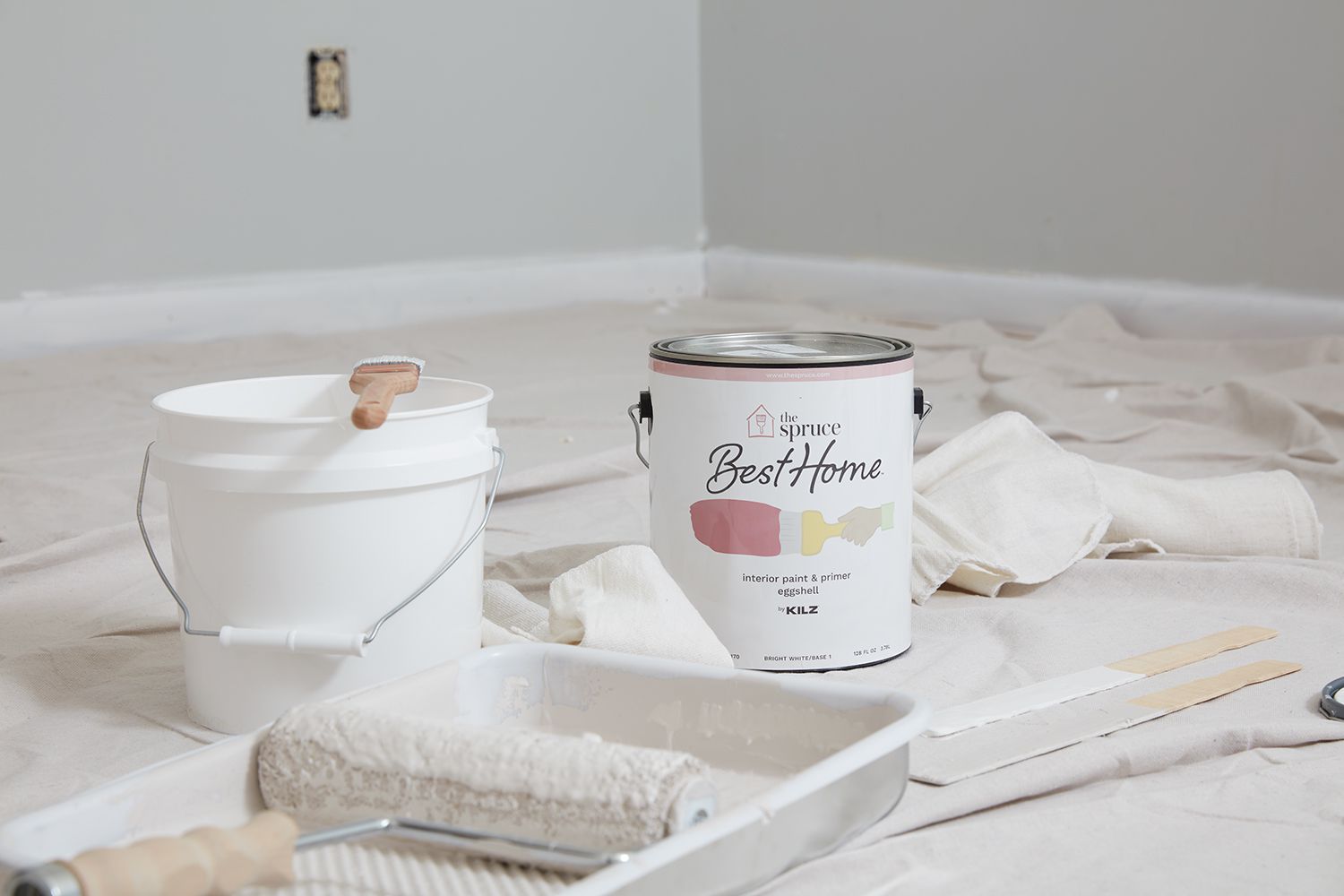Determining the Shelf Life of Paint: When to Discard Old Cans
Embarking on a painting project breathes new life into your living room or adds a splash of personality to your kitchen cabinets, but what happens to the leftover paint that inevitably ends up shelved in the garage or basement?
While it may seem like paint lasts indefinitely, there’s a science to its longevity that many of us overlook. This compromises the quality of future touch-ups and potentially creates unnecessary waste.
Knowing whether your old paint can still bring color to your world or if it’s time to bid it farewell is as much an art as it is an essential resource management skill.
In this article, I’ll delve into the intricacies of paint shelf life, equipping you with the knowledge to assess the usability of your stored gallons and quarts accurately. This understanding will empower you to make informed decisions about your painting projects.
Please keep reading to ensure your next painting shines with enduring vibrancy and understand when it’s prudent to part ways with aging cans. For instance, you can donate usable paint to local community centers or schools, recycle empty paint cans, or dispose of unusable paint at a hazardous waste facility.
Understanding Paint Shelf Life: A Comprehensive Guide
Embarking on a painting project breathes new life into a space, but before I dip my brush into a vibrant color, I must assess the condition of my paint.
Different paints—from latex to oil-based—boast varying lifespans, and recognizing these nuances is essential.
By understanding the importance of proper storage, you can significantly extend the vitality of your paint cans. This proactive approach ensures a flawless finish on any porch or room you rejuvenate, making you a responsible and efficient painter.
It is crucial to be vigilant about the cues painting supplies provide. Your ability to spot signs of degradation can differentiate between a flawless coat and a disappointing result. This attentiveness ensures the quality of your work and enhances your painting skills.
In this guide, I share the critical points of paint preservation and the telltale red flags indicating it’s time for fresh supplies.
Identifying Different Types of Paint and Their Shelf Lives
As a seasoned house painter, I’ve learned that navigating the shelf life of various paints is akin to consulting a detailed map before a long journey: it’s crucial for a triumphant arrival at your destination—a beautifully finished project. From the lush eggshell finish gracing a client’s living room to the durable gloss on a weather-worn porch, each type of paint—from latex to acrylic, oil-based to epoxy—carries its temporal stamp. Knowing precisely how long each can retain its usability not only prevents the inconvenience of mid-project shortages but also ensures every stroke of my brush delivers the quality my customers expect.
Type of Paint:
- Expected Shelf Life (Unopened)
- Expected Shelf Life (Opened)
| Latex | Acrylic | Oil-Based | Epoxy |
| 2-5 Years | 2-5 Years | 5-7 Years | 1-2 Years |
| 1-2 Years | 1-2 Years | 2-5 Years | 6 Months – 1 Year |
How Proper Storage Affects Paint Longevity
Ensuring my paints are stowed correctly radically influences their shelf life and performance. Much like a gardener who carefully stores seeds for optimal germination, I treat my paint cans with similar reverence, storing them in a controlled environment that shields them from the extreme temperatures and moisture that would otherwise spoil their contents. By paying close attention to how my cans are sealed and shelved, I assure myself that the next painting project will start on the right foot with materials that have yet to be degraded a bit since their last use.
- Seal the lids tightly to prevent air from drying out the paint.
- Store at moderate temperatures, avoiding freezing conditions or excessive heat, which can ruin the paint’s consistency.
- Keep cans off direct ground contact to guard against rust and moisture intrusion.
- Place in a dry area to fend off the potential for water damage.
- Label each can with the date of purchase and opening to track usability effectively.
Signs That Your Paint Has Gone Bad
Discerning the condition of paint is critical before initiating a painting project, as outdated or spoiled paint can compromise the aesthetic and durability of the job. Telling signs abound when a can of paint has reached its expiration: a pungent odor akin to that of sour milk, a skin formation on the surface upon prying open the lid, or a consistency that refuses to blend even after a thorough stirring are clear indicators it’s time to dispose of it properly:
- A robust and tangy scent wafting from the can.
- Skin formation or lumps on the surface of the paint.
- Consistency that won’t smooth out, indicating irreversible separation.
The Science Behind Paint Expiration
Peering into the science of paint expiration is akin to examining the inner workings of a well-oiled machine; each part plays a pivotal role in the overall performance. Paint is no different, with its various components, each susceptible to the passage of time. The pigments, binders, and solvents all have unique expiration cues, and understanding these can help you prevent your painting project from faltering.
Paint is no different, with its various components, each susceptible to the passage of time.
The pigments, binders, and solvents all have unique expiration cues, and I must analyze these variables to prevent my painting project from faltering.
The effects of temperature fluctuations and humidity are not to be underestimated either—they stealthily impact my paint cans, accelerating the degradation process.
Understanding these intricate details is what sets a seasoned painter apart. It ensures the preservation of quality in every brushstroke I apply.
Analyzing Paint Components: What Expires?
Diving into the core of what may cause paint to expire, I scrutinize the synergy between pigments, binders, and solvents closely. Separate and intrinsic, these components each react to time and environment—while pigments may clump, binders may lose their cohesiveness, and solvents may evaporate, each altering the original composition of the paint, potentially leading toward its expiration and compromising my painting project.
How Temperature and Humidity Contribute to Paint Degradation
As a professional house painter, my brushes have dipped into countless cans of paint, where each hue’s fate is tied to its environment. Unseen by the layman, temperature highs and lows and wavering humidity levels play a subtle but critical role in breaking the delicate equilibrium within a can of paint: high temperatures can hasten the evaporation of essential solvents, leading to thickened or dried-out paint. In contrast, humidity invites unwanted moisture, compromising paint quality and longevity and even promoting mold growth.
- Heat accelerates solvent evaporation, resulting in thickened or dried-out paint.
- Excess moisture from high humidity levels can introduce contaminants, promoting mold growth and paint spoilage.
- Freezing temperatures can damage paint consistency, rendering it unusable upon thawing.
Step-by-Step Guide to Assessing Old Paint
Determining when to let go of old paint involves a keen eye and a bit of know-how.
My process begins with carefully examining the paint can for any rust or structural damage that could compromise the paint.
From there, I’ll move to a hands-on assessment, giving the contents a good mix to check for evenness and consistency.
There’s an art to recognizing when paint has outlived its purpose—a skill I’ve honed over countless projects.
Lastly, no inspection is complete without the smell test.
A rancid odor is a dead giveaway that it’s time to retire a can.
While these procedures may sound simple, following these key steps is vital for delivering top-tier results for every surface, from the molding around a stately fireplace to the vibrant walls of a freshly updated bedroom.
Inspecting the Can for Rust and Damage
My first step in evaluating a paint can’s viability involves meticulous inspection for any signs of rust or damage to the container. A compromise can indicate that the paint’s integrity has been breached, which could lead to contamination, skinning on top of the paint, or worse yet, compromised seal integrity, which allows solvents to escape or unwanted moisture to seep in.
Testing the Paint: Mixing and Consistency Checks
Once I’ve ascertained that a paint can’s exterior is free from damage, my attention shifts to the substance within. Delicate stirring is essential; a gentle whirl of the stir stick can reveal much about the paint’s condition. Suppose the paint fuses back into a uniform, smooth medium without the appearance of clumps or an inconsistent texture. In that case, it suggests that the paint is still vibrant, retaining its original character, ready for the next stroke of my trusted brush.
Smell Test: Identifying Rancid Paint
The olfactory test is a pivotal moment in assessing an old paint can: our sense of smell can detect chemical changes that indicate paint spoilage. A foul, off-putting scent signals the presence of bacteria or mildew, suggesting the paint’s integrity has been compromised and it’s time to dispose of the can safely:
- Open the paint can and carefully sniff; assess for unpleasant odors.
- Identify musty, sour, or otherwise abnormal smells that differ from fresh paint.
- Determine if the off-odors suggest spoilage, indicating the paint is no longer suitable.
The Do’s and Don’ts of Disposing of Old Paint
Choosing the right moment to dispose of old paint transcends mere housekeeping; it solidifies my commitment to environmental stewardship and safeguards my plumbing from hazards.
As the final act of my painting project, responsible disposal is a testament to professionalism and respect for our shared environment.
Below, I outline the most environmentally safe methods for discarding unused paint and underscore the importance of never resorting to the drain. This act could harm our waterways and burden our community’s waste management systems.
Environmentally Safe Ways to Discard Unused Paint
In my commitment to eco-responsibility, I ensure unused paint meets its end in the most harmless manner possible. I often turn to local recycling programs, which welcome old cans and repurpose their content, or I opt for specialized hazardous waste facilities equipped to handle the disposal of leftover paint without compromising the environment. This act aligns with my dedication to stellar customer service and reflects my deep respect for our planet.
Why You Should Never Pour Paint Down the Drain
Remedying a surplus of old paint demands responsibility; pouring it down the drain is a mistake I consciously avoid, fully aware that such an action can contaminate water systems and adversely affect wildlife and water treatment facilities. The intricate balance of our ecosystems and the complexities of water filtration and purification underscore my stance never to treat the drain as a means for paint disposal, emphasizing my deliberate choice to protect our shared environmental resources.
Maximizing Your Paint’s Shelf Life: Best Practices
Embarking on a painting project, I always emphasize to clients the importance of preserving their paint’s shelf life to get the most value from their investment.
My professional experience has shown that meticulous paint storage can make all the difference, allowing a can to last till the final stroke of the brush on a cabinet or ceiling.
Here, I’ll articulate three cornerstone practices:
- Ensuring lids are sealed with precision to thwart any air infiltration.
- Creating an ideal climate in terms of temperature and humidity for storage.
- Revealing an innovative upside-down method that assists in maintaining a hermetic seal.
These actionable tips are vital for any homeowner or fellow tradesperson aiming to optimize paint longevity and quality.
The Importance of Tightly Sealed Lids
Maintaining a tightly sealed lid on my paint cans is an avid practice I advocate for. It’s a simple yet highly effective method to prevent air from sneaking in and drying out the paint, thus preserving the paint’s consistency and preventing skin from forming on the surface:
Sealing Method
Benefits
- Use of rubber mallet: Ensures even, secure lid closure without deforming the lid or can
- Plastic wrap under the lid: Adds an extra layer to deter air leakage and extend paint shelf life
- Storing cans upside-down: Creates a natural seal through the paint’s weight, reduces air infiltration
Ideal Conditions: Temperature and Humidity Guidelines
Storing my paint under the proper conditions is a ritual I adhere to religiously, recognizing that the life expectancy of each can is greatly influenced by its storage environment. I ensure my paints are nestled in an area where temperature and humidity levels are moderate—above freezing yet cool enough to prevent the breakdown of components—because maintaining this balance is vital for preserving paint’s viscous nature and preventing premature spoilage.
Upside-Down Storage Trick to Seal Out Air
Over time, I’ve adopted the upside-down storage trick to ward off air infiltration. This technique leverages the weight of the paint itself to maintain a seal around the lid’s edges. Inverting the can after ensuring the lid is firmly in place helps to create an airtight barrier, thus extending the paint’s usefulness. It’s a simple but smart step in my housekeeping routine that counters paint spoilage with gravity’s help.
FAQs on Paint Shelf Life and Disposal
Questions often arise as I guide clients through the intricacies of a painting project, especially regarding the longevity and disposal of their paint supplies.
- Can a once-vibrant gallon, seemingly past its prime, be brought back to life?
- Are there risks in applying a coat of paint that’s reached its expiration date?
- And once a project ends, what’s the most responsible way to handle excess products?
Addressing these concerns, I’ll explore whether old paint can be rejuvenated, the implications of using expired paint, and the eco-friendly avenues for recycling or donating any surplus, ensuring we honor the artistry and environmental responsibility.
Can Old Paint Be Revived for Use?
As I engage with clients, guiding them through their painting tasks, a recurring inquiry surfaces: can old paint be resuscitated? My response, grounded in experience, is cautiously optimistic: while certain old paints can be restored to a usable state with thorough stirring and possible thinning, it hinges on the paint not displaying signs of spoilage. If the smell is acceptable, and the consistency returns after mixing, there’s a chance for it to grace walls once more:
- Assess the paint for foul odors – if none, proceed to the next step.
- Mix rigorously to see if the consistency smoothes out.
- If necessary, thin sparingly with the appropriate solvent to achieve the desired viscosity.
Is It Safe to Use Expired Paint?
When using expired paint, your project’s safety and aesthetic outcome are paramount. Paint past its prime may fail to adhere properly, resulting in a patchy and unprofessional finish. It could also harbor harmful bacteria, especially if it has developed an off-odor. Therefore, I always advocate for erring on the side of caution and avoiding using paint indicating expiration.
How to Recycle or Donate Unwanted Paint
Continuing our journey towards eco-conscious painting solutions, I turn the spotlight on how to give excess or unwanted paint a second lease on life. Properly recycling or donating paint not only clears space in my storage area but also supports community projects and reduces environmental impact: I locate local programs where paint is accepted for recycling or repurposing, and I identify charitable organizations that welcome paint donations for their initiatives in art, education, or housing restoration.
- Locate and contact local recycling centers or hazardous waste facilities that accept paint.
- Find charitable organizations or community service groups that can benefit from donated paint.
- Ensure the paint is in good condition and sealed adequately before donation to avoid liability issues.
Understanding the shelf life of various paints is vital for ensuring the integrity of your painting project and avoiding waste.
Proper storage techniques are essential for extending paint longevity, and being able to identify signs of degradation helps protect the surface’s aesthetic.
Properly disposing of old paint demonstrates a dedication to environmental conservation and upholding professional norms.
Ultimately, being informed about when to use or discard paint guarantees the quality of your work and the efficient management of resources.



